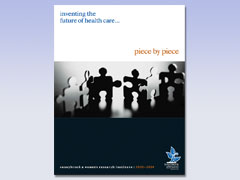Spotlight on Breast Cancer Research: Let's Get Digital
Early detection means early diagnosis and, for some women, a chance to live a life that might otherwise be snatched away.
In 2003, invisible tumours became visible. Senior scientist Dr. Martin Yaffe, working with Dr. Roberta Jong, director of breast imaging, published the first results showing that contrast-enhanced digital mammography could "see" breast cancer tumours that regular film mammography sometimes misses. And we're not talking about the vague outline of "something" in the tissue – we're talking about high-contrast, high-resolution images. Digital mammography can illuminate a lesion the size of a wild blueberry.
It was a pivotal finding in breast cancer research. The contrast agent, or dye, that is used marks where new blood vessels are growing, and thus may allow specialists to detect cancer earlier. Early detection means early diagnosis and, for some women, a chance to live a life that might otherwise be snatched away. This finding is especially relevant for women with dense breasts, who are often young, because the thickness of their breast tissue can hide tumours from film mammography, essentially rendering them invisible.
A true lab-to-bedside success story, digital mammography is now used all over the world. Meanwhile, Yaffe and his team continue to develop and refine digital techniques.
He's been doing imaging research at SWRI for 15 years, and his drive is obvious. Of his main goal, he says, "We're trying to move forward the whole area of breast cancer detection. It's very exciting. Because of better detection and treatment, we're seeing the mortality from breast cancer going down. That's the main focus – we've got an important problem that affects people's lives, and not just the people who get it, but their families and those around them."
Yet, he also radiates matter-of-factness – for all his achievements, and the resultant recognition, he says quietly, "This is what our lab does – we develop technology and techniques to refine and optimize imaging detection." Simply stated, but that's a lot of puzzle pieces to assemble.
Digital tomosynthesis is one technology with promise. Yaffe and his lab – he firmly points out that results come from working with top-tier engineers, graduate students, and others – have been collaborating with General Electric since late 2003. In digital tomosynthesis, multiple X-rays of the breast are taken from various angles. These are then sent to a computer that constructs three-dimensional images that can be scrutinized. This deals with the problem of overlapping tissue in regular mammography that causes some shadows to be mistaken for lesions.
They're also testing if the procedure is more comfortable for women, because it might be possible to use less pressure. If screening is more comfortable, then women are more likely to get it done – another good way to raise detection rates.
Although digital mammography is being used in clinics, this is not yet the case with the other techniques, like tomosynthesis, that Yaffe is refining. Most are translational research in progress. That is, they're not yet widely available, but they likely will be in less than a decade. It's a process.
"We try to take our conclusions and move them forward in a logical way," says Yaffe.
Piece by piece, one might say.
The Canada Foundation for Innovation, the Canadian Breast Cancer Research Alliance, the Canadian Institutes of Health Research, the Ontario Research and Development Challenge Fund, The Terry Fox Foundation and the National Cancer Institute (U.S.) funded Yaffe's research.
PDF / View full media release »


